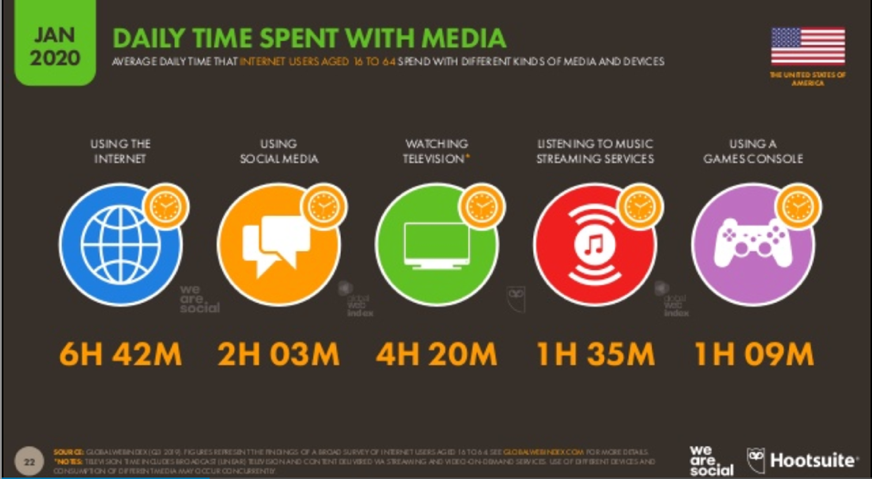The media landscape of today is more diverse, segmented and varied than ever. Every day, consumers are searching online, scrolling through social media, watching or streaming TV, listening to streaming music services and engaging through gaming platforms.
Research compiled by Hootsuite shows just how much time Americans are spending with media.

According to a 2018 Nielsen audience report, U.S. adults spend a total of 10 hours and 30 minutes per day connected to media. Given all of these hours, there’s an obvious opportunity for marketers and advertisers to reach target audiences on these channels.
Even though digital advertising spend surpassed traditional for the first time ever in 2019, capturing more than half of all dollars spent by advertisers, we’re far from dismissing channels like print, radio and television. In fact, the Nielsen report found that 92% of U.S. adults listen to radio each week. The ecosystem of paid media relies on an omnichannel approach, using both digital and traditional media to reach desired audiences.
Optimize your ads
While it’s not uncommon for organizations to execute their own media campaigns—without the help of an agency—managing those campaigns can quickly become overwhelming and the results can often be disappointing or confusing. This is where partnering with a media team can help tremendously.
At ddm, our experienced media buying team uses the most up-to-date software and monitoring platforms to ensure your campaign is running smoothly and continually optimized for success. Our team would be happy to partner with you to develop a campaign strategy that meets your company’s marketing goals, but we also recognize that you may be looking for some simple guidance to create a media strategy on your own.
To that end, here are the top three media buying pitfalls to be aware of before launching your next media campaign.
Media Buying Pitfalls
- Not using the right data: There are many sources of media usage data out there. Many have built-in bias, or, even worse, biased interpretation, resulting in headlines that are less than accurate. Using the right data is crucial, because it ensures the media buy is reaching the right people, in the right place, at the right time. Without accurate data, you could potentially be dumping thousands of dollars down the drain. Working with a media buyer allows you to have an expert on your side who knows the industry and how to distinguish accurate data from clickbait headlines or biased sources. This results in a media buy that is built on a solid foundation and tailored to accomplish your goals.
- Not enough reach and frequency: While many go-to-market strategies are debated in the media business, one that pretty much everyone agrees on is that without high enough reach and frequency, your campaign will not work. Consumers are busy and distracted. They don’t perceive your ad campaign the same way that you do, unfortunately. For a campaign to work, your message needs to be seen again and again. And it needs to reach enough of the community to yield a response. Working with a media buyer allows access to tools that evaluate reach and frequency by combining multiple vendors across a market. Without this type of insight, you may be not reaching your consumer well enough or, even worse, spending too much and achieving frequency that is too high.
- Relying on only one or two media types: Have you ever thought to yourself, “I’ll try print this month, television next month and then compare the results to see which one works best”? It’s a common pitfall. The truth is, media buying yields the best campaign with an omnichannel approach. When customers see your message in multiple places and types of media, it creates a synergy that results in each media type being much more effective than it would be on its own. It’s important that your message is consistent across media types and that timing is coordinated so they are running in conjunction with each other. Learn more about how we coordinate the right messages across each channel.
KPIs and Metrics
As a final note about media buying, we’d like to leave you with some thoughts about KPIs and metrics. First, we encourage you not to undervalue reach, frequency and engagement metrics. A majority of overarching marketing goals and objectives revolve around customer acquisition and retention, but achieving these goals isn’t something that happens overnight. Customers are doing much more research on their own before they surface as a lead or make a purchase. Those top and mid-funnel metrics at the front end of your buyer’s journey are just as important as the conversion metrics.
Engagement metrics give advertisers information about whether or not the right audience is being reached and how that audience interacts with your company’s messaging and website. By testing different messages and regularly adjusting your campaigns, you can increase the performance of your advertising efforts. When you pay attention to metrics that reflect audience engagement, it can lead to a more fluid user experience with your brand. And that holy grail of consistent messaging that reaches and impacts your audience is what will help you achieve your overarching marketing goals.
